

Collection: Breaking Down Stereotypes. Teen Health, Part II: Body Image and Social Media. Theconversation. Social media is a wonderful way to connect with others, share experiences and opinions and express ideas.
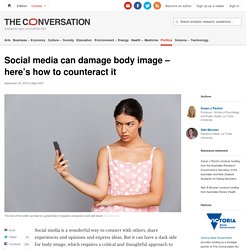
But it can have a dark side for body image, which requires a critical and thoughtful approach to counteract. People who have body image concerns feel worried, distressed and unhappy about their appearance, weight or shape. They may be concerned about being too large, too small, not curvy enough, or not muscular enough. Body dissatisfaction of this kind causes a great deal of distress and can lead to severe psychological and physical problems. Consequently, body dissatisfaction has been identified as a serious public health problem. A Guy's Guide to Body Image. Listen The Truth About Guys People might think of guys as carefree when it comes to their appearance.

But a lot of guys spend plenty of time in front of the mirror. The Impact of Negative Body Image on Boys. Is There A Link Between Social Media Use and Negative Body Image? – It's a Globalised World… Body image issues perpetuated and distorted by social medias, like Facebook (Ellis 2013).

“The More time spent on Facebook, the more likely people are to self-objectify” – Phillippa Diedrichs (Roxby 2014). The power the media has over its consumers is palpable. The idea of body image is a constant that comes up within the media’s realm with many negative connotations attached to it. Our Health, Our Futures - Eating Disorders - The Media and Body Image. Boys and Body Image. Cheeseburgers: So sexy! Check Out More Offenders: Contact Carl’s Jr.

/Hardee’s and let them know what you think of their over-sexualization of women. CEO: Andrew F. Body image. Step one: Raise your awareness about media messages and learn how to really SEE what you're watching, listening to, or reading.
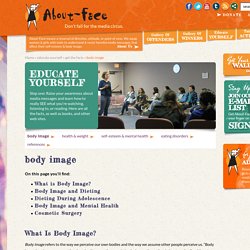
Here are all the facts, as well as books, and other web sites. Women’s Bodies in Advertising - Our Bodies Ourselves. “Feminine odor is everyone’s problem,” proclaims an ad for a feminine hygiene spray.
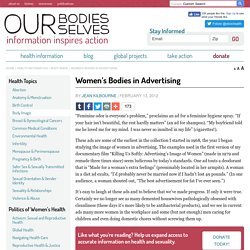
“If your hair isn’t beautiful, the rest hardly matters” (an ad for shampoo). “My boyfriend told me he loved me for my mind. I was never so insulted in my life” (cigarettes!). These ads are some of the earliest in the collection I started in 1968, the year I began studying the image of women in advertising. The examples used in the first version of my documentary film “Killing Us Softly: Advertising’s Image of Women” (made in 1979 and remade three times since) seem ludicrous by today’s standards.
It’s easy to laugh at these ads and to believe that we’ve made progress. Media and Body Image. Written by: Joel Miller The media has a profound effect on people, particularly women, and the way that they perceive themselves and their bodies.

Thanks to television, the Internet, and movies, media has a strong hold on women's personal perceptions of what beauty is supposed to be. Body image - View - GDHR Portal. Overview We live in a world that sends us all sorts of messages about the ‘perfect’ body.
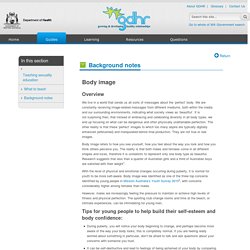
We are constantly receiving image-related messages from different mediums, both within the media and our surrounding environments, indicating what society views as ‘beautiful’. It is not surprising then, that instead of embracing and celebrating diversity in all body types, we end up focusing on what can be dangerous and often physically unattainable perfection. The other reality is that these ‘perfect’ images to which too many aspire are typically digitally enhanced (airbrushed) and manipulated before final production. They are not true or real images. Body image refers to how you see yourself, how you feel about the way you look and how you think others perceive you. With the level of physical and emotional changes occurring during puberty, it is normal for youth to be more self-aware. Tips for young people to help build their self-esteem and body confidence: Women React To Realistic Disney Princess Waistlines. Refocusing Body Image in the Age of Photoshop.
We Asked Five Models to Get REAL About Body Image, and You Won't BELIEVE Their Answers. Watch 5 Boys Open Up About Being Body Shamed. 10 WAYS WE BODY SHAME WITHOUT REALIZING IT: 1.... Why is the hourglass figure the only version of plus size that we see? Photo: via Vogue Last week, Vogue made headlines for publishing an online editorial dedicated to curvy women dressed in plus-size lingerie.
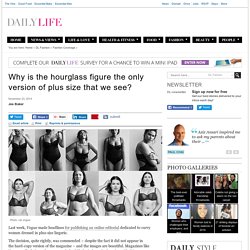
The decision, quite rightly, was commended – despite the fact it did not appear in the hard-copy version of the magazine – and the images are beautiful. Magazines like Vogue really do have the power to help shift the industry’s obsession with thinness. The first 'plus size' male models - Life Matters - ABC Radio National. New Dressmaking Dummy Based on the Average Form of Young Adult Females. Research>Digital Human for Human Centered Design A dressmaking dummy is not a manikin to display dresses.

The dummy is a tool to make clothes patterns through draping. Therefore, its bust, waist and hip conform with the dimensions standardized in JIS, and its form is close to that of the human torso. In traditional dressmaking dummies, however, the cross-section shapes of bust, waist and hip, as well as the form between these cross sections are made manually according to experience and artistic sense. Thus, its overall form is different from that of the actual human body. In a collaboration study with Bunka Fashion College, we developed a new dressmaking dummy based on the average dimensions of actual human body forms.
Lingerie retailer's #ImNoAngel campaign takes aim at Victoria's Secret. The ads star models Ashley Graham, Marquita Pring, Candice Huffine, Victoria Lee, Justine Legault and Elly Mayday A lingerie retailer is fighting Victoria's Secret's beauty standards head-on with its new marketing campaign. Lane Bryant has debuted its Spring/Summer lingerie collection - if you're in the northern hemisphere that is - with the advertising slogan I'm No Angel. Proof that one size does not fit all. A Brandy Melville model (left) and two BuzzFeed staff try on a 'one size fits all' skirt. Photo: Brandy Melville/ BuzzFeed We've always been suspicious of 'one size fits all' clothing. Because, err, how could it possibly?
Adol ch13. How do the media affect a teen's body image? More than ever, teens are exposed to a dizzying array of media outlets. While parents used to just worry about how much time their teens spent watching television, the Internet, smart phones, magazines, and publicly displayed television (e.g. at school, malls, etc.) increase teens' media exposure exponentially. All these mediums tend to provide very mixed messages about what makes someone physically attractive as opposed to what's healthy, and then add another layer of confusion by promoting often unhealthy behaviors and foods.
The result is that teens can often have unrealistic expectations about what their bodies should look like, while being encouraged to try the very things that are unhealthy for their bodies. A study on fifth graders showed that both boys and girls expressed dissatisfaction after watching a Britney Spears video or an episode of "Friends" [Source: Teen Health]. Life & Body Image Issues for Teens. People all over the world use the media every day. Whether it's using a computer, watching TV, reading a newspaper, talking on the phone, or listening to the radio – many of us interact with media daily.
Through the media, you can find out about important news, listen to your favorite music, or watch your favorite TV show. But there are also negative sides of the media that can be especially harmful to teens and young adults like you. Listed below are some of the ways that certain types of media can negatively affect your life. School According to Common Sense Media, kids who watch a lot of TV have smaller vocabularies and lower test scores in school. Another study shows that the people with the highest degrees watched less TV as kids and teenagers. Back to top Obesity.